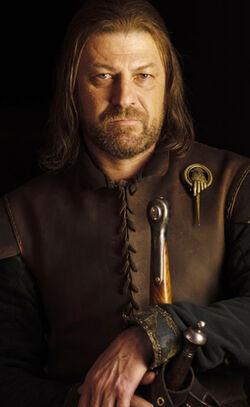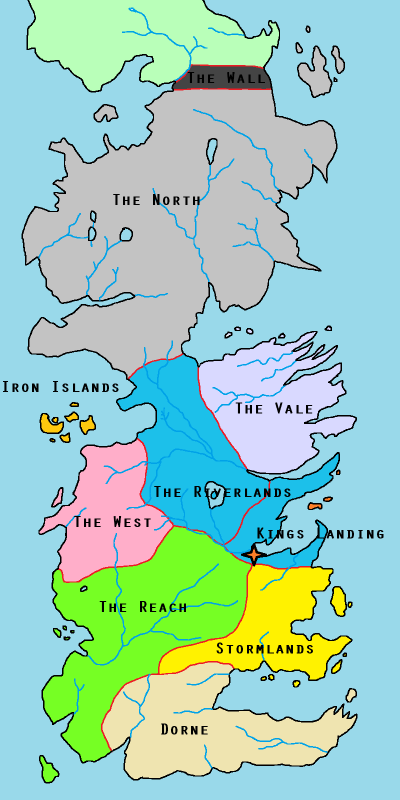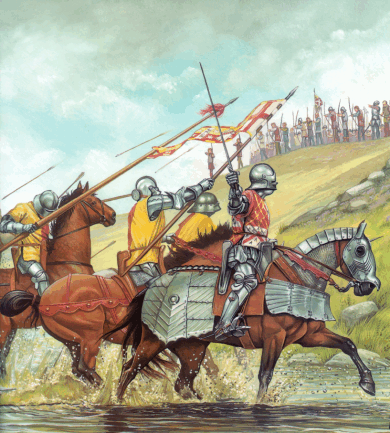Ned, however, was imprisoned for treason and his confession in the Sept of Baelor didn't dissuade Joffrey from having Ned beheaded and put on the battlements of the Red Keep. York would never get the chance to inherit the throne after dying in battle during December 1460 and he too would have his decapitated head spiked and put on display.
The wives of Lord Stark and York would also share similarities. Lady Catelyn Stark, played by Michelle Fairley, was part of the Riverlands' House Tully whilst Duchess of York, Cecily Neville, was of the northern Neville family.
 |
| Catelyn Stark would negotiate terms for her son's rebellion |
York's wife was known as 'Proud Cis' and Catelyn would also share this trait as she hated to be reminded of Ned's infidelity and acted coldly around Ned's bastard son, Jon Snow.
Catelyn was actively involved in negotiating alliances with Lord Walder Frey and Renly Baratheon. Cecily would also negotiate for peace with Margaret of Anjou and the Council following her husband's several challenges to royal authority. Lady Stark's sister, Lysa, had married Lord John Arryn who would die as Hand of the King and caused Lysa to remove herself to the Vale of Arryn. The Stark sisters reunion at the Eyrie didn't go as Catelyn would have liked as Tyrion Lannister escaped execution and Lysa refused to commit troops to the Stark cause.
 |
| Cecily Neville would outlive her husband and 13 children |
Cecily would also be reunited with her sister, Anne, in harsh circumstances after York had fled the battlefield and left his Duchess to the mercy of the Lancastrian forces. Cecily and her three youngest children were placed under the care of Anne Neville, Duchess of Buckingham, who was married to the Lancastrian commander, Henry Stafford, Duke of Buckingham.
The fates of Lady Stark and the Duchess of York would however differ. Cecily would live to the age of 80, outliving all of her 13 children, two of which became kings, and saw her grand-daughter become queen. Catelyn would live a much shorter live after falling victim to Walder Frey's betrayal and was killed alongside her eldest son, Robb at the Red Wedding.
Robb Stark, played by Richard Madden, had taken up arms in his father's defence and was named King of the North by his men. The eldest son of York, Edward IV would also take up arms following his father's death and would be proclaimed King of England in March 1461. Edward IV's victory at Towton confirmed his rule and was similar to Robb's victory at the Whispering Wood.
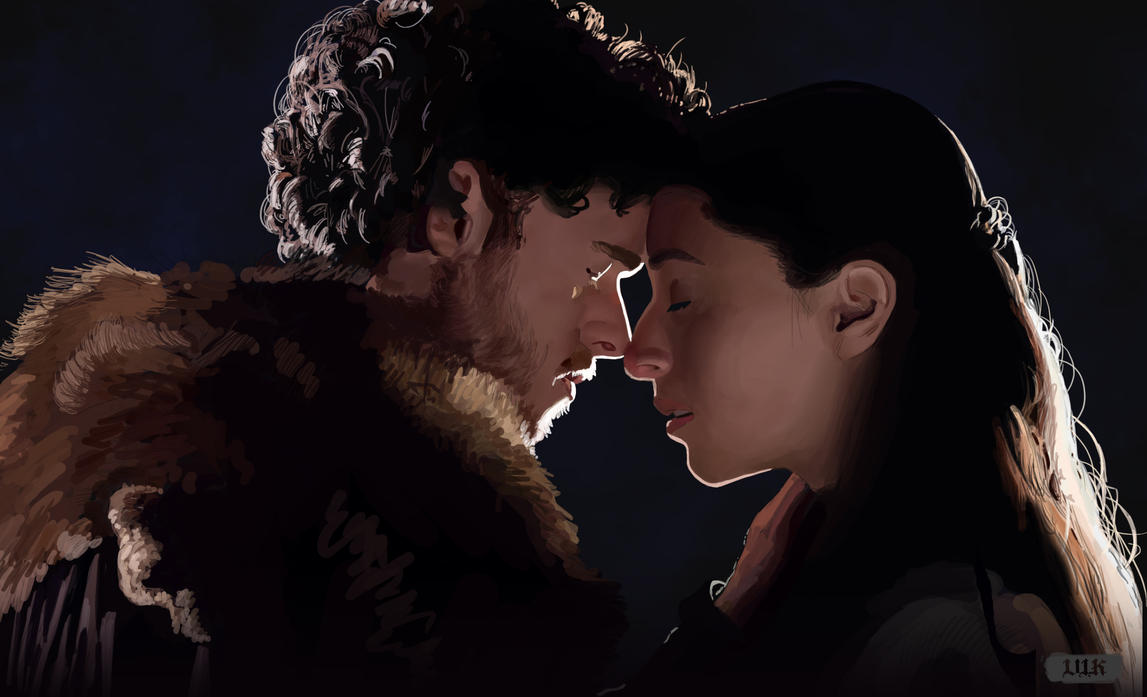 |
| Robb Stark's marriage was similar to Edward IV's |
Robb marched south from the Twins after negotiating a crossing with Walder Frey that involved Robb's betrothal to one of Frey's daughters. The betrothal was soon abandoned by Robb when he married Talisa Maegyr (played by Oona Chaplin)and this unwanted marriage was similar to Edward IV's union with Elizabeth Woodville.
 |
| Edward IV was a valiant young King |
The Earl of Warwick was negotiating a marriage between Edward IV and a European princess when the king married the daughter of a former squire and this alienated Warwick. Edward IV's uncle would unsuccessfully rebel against the king and was killed at the Battle of Barnet whilst Walder Frey was more successful by betraying Robb, his mother, his wife and unborn child who were killed at the Red Wedding.
Robb was himself betrayed by the Stark ward, Theon Greyjoy (played by Alfie Allen), and was reminiscent of George, Duke of Clarence's betraying his brother, Edward IV. Theon suggested a Stark/Greyjoy alliance to his surrogate brother and Robb allowed him to propose this alliance in person to Theon's father, Balon Greyjoy. This reunion would see Theon looking to prove himself to his father by betraying Robb and attacking Stark's home of Winterfell.
 |
| Theon Greyjoy couldn't resist his Iron Island roots |
Clarence had aligned himself with Warwick following his brother's marriage to Elizabeth Woodville and this was affirmed with Clarence marrying Warwick's eldest daughter, Isabel Neville. Warwick's plan to overthrow the king and crown Clarence with his grandson as heir was soon thwarted and Warwick looked instead to an alliance with the exiled Margaret of Anjou. Clarence felt betrayed by Warwick and joined his brother's side at the Battle of Barnet in 1471 where they defeated Warwick.
 |
| George, Duke of Clarence, betrayed his brother |
Clarence would soon rebel against Edward IV after his wife had died and would be executed for treason in 1478 by being drowned in a butt of Malmsey wine. Theon's confident and brash persona would die when he was captured and tortured by Ramsey Snow but it remains to be seen whether Theon can return to glory.
The Stark family is now led by the eldest daughter, Sansa Stark, played by Sophie Turner, who has transformed throughout the TV series. The naive 'little dove' had seen her Prince Joffrey take the head of her father and sadistically ridicule her. The Lady of Winterfell was married to Tyrion Lannister as a strategic match which Littlefinger wanted and engineered to possess the heiress of the North.
 |
| Sansa Stark, Lady of Winterfell, is highly sought after |
Elizabeth of York was Edward IV's eldest daughter and was seen as a strategic match to end the Wars of the Roses. In December 1483, Elizabeth Woodville and Margaret Beaufort, mother of Henry Tudor, agreed to the marriage of Elizabeth of York and Henry Tudor that was realised in January 1486. This marriage would unite the warring York and Lannister families and was symbolised by the Tudor Rose.
 |
| Elizabeth of York became Queen |
Elizabeth of York's brothers, King Edward V and Prince Richard, were last seen housed in the Tower of London in late 1483 and were presumed dead, just as the youngest Stark boys, Bran and Rickon were when Theon Greyjoy falsely displayed two charred farm boys as the Starks.
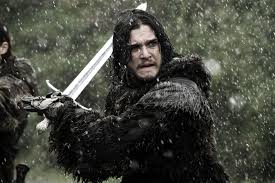 |
| Jon Snow, like Richard, Duke of Gloucester, fought in the North |
Ned Stark's bastard son, Jon Snow, played by Kit Harrington became a Man of the Night's Watch and defended The Wall against the Wildlings. Richard, Duke of Gloucester was named Lieutenant-General of the North in 1480 by his brother, Edward IV. Richard raged war against the Scots and recaptured Berwick-upon-Tweed in 1482.
HOUSE LANNISTER/LANCASTER
House of Lancaster originated from the descendants of John of Gaunt, Duke of Lancaster and ruled England for over 60 years.
Henry V was the most famous Lancastrian king, showing warrior-like qualities in defeating the French at Agincourt and Jaime Lannister, played by Nikolaj Coster-Waldau, was known as the greatest swordsman in Westeros. Jaime's illegitmate son, Joffrey, would take the throne under the guise of King Robert's son and would show signs of madness as did Henry VI.
 |
| Jaime Lannister and Henry V showed their prowess with a sword |
Henry VI's first mental breakdown coincided with the birth of his only son, Edward of Westminster, who shares similarities with King Joffrey (played by Jack Gleeson) who took pleasure in meeting out justice to his captors.
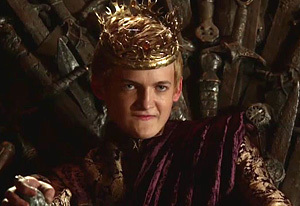 |
| The sadistic King Joffrey |
Prince Edward was exposed to cruelty from an early age when the five-year-old boy witnessed the Lancastrian victory at the Second Battle of St. Albans. Margaret of Anjou asked her young son how the two York knights held captive should be killed and the prince requested death by decapitation, an order repeated by King Joffrey for Ned Stark.
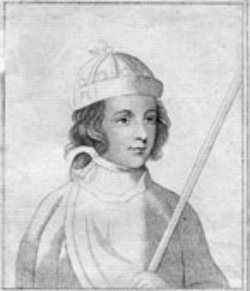 |
| Prince Edward was aged five when he passed judgement of execution |
Margaret of Anjou looked to reaffirm her son's birthright by aligning with the Earl of Warwick who betrothed his daughter, Anne Neville, to Prince Edward.
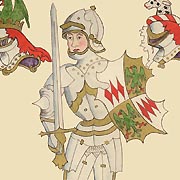 |
| The "Kingmaker" Earl of Warwick |
The Earl of Warwick was known as the Kingmaker for his decisive military and political actions whose lands and titles gave him vast wealth and served as inspiration for the Lannister patriach, Tywin Lannister, played by Charles Dance.
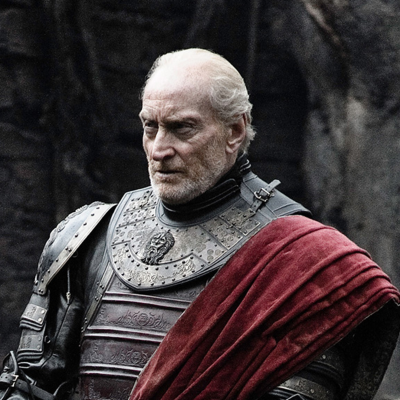 |
| Tywin Lannister |
Tywin was also the richest man in the land and served twice as Hand of the King, betrothed his daughter to King Robert and saw his two grandsons sit on the Iron Throne. Tywin, like Warwick, looked to affirm his power by negotiating favourable marriages and he betrothed Cersei once again and his two grandsons to the powerful Tyrells. Joffrey's marriage to Margaery Tyrell didn't last a day after he was poisoned at the wedding feast and Prince Edward would also die young at the Battle of Tewkesbury in 1471.
Joffrey's mother, Cersei Lannister, played by Lena Headey, draws inspiration from Margaret of Anjou and Elizabeth Woodville. Cersei would act as Queen Regent during Joffrey's minority and looked to wield power but was unable to control her son.
 |
| Queen Cersei divided many in King's Landing |
Margaret of Anjou had several admirers at court, the biggest being the 2nd Duke of Somerset. Somerset had negotiated the royal marriage and carried the young queen-to-be ashore when she arrived in England. Queen Margaret returned this by awarding Somerset several titles and intervened numerous times when others called for Somerset's arrest. Many wondered whether Prince Edward was a result of an adulterous liaison between the queen and Somerset, a relationship that somewhat resembles the Lannister twins of Cersei and Jaime.
 |
| Margaret of Anjou's favourtism resembled Cersei's |
This incestuous relationship bore illegitimate children which were revealed as such by Ned Stark and, more publicly, by Stannis Baratheon. Elizabeth Woodville would also see her children declared bastards after an Act of Accord in 1483 ruled that Edward IV was betrothed to another when Woodville married the king.
HOUSE BARATHEON/LATER YORK
King Robert Baratheon, like Edward IV, had won a valiant war to claim the throne but times of peace allowed both kings to revel in royal luxuries. King Robert, played by Mark Addy, was over-bloated after years of excess food and drink and would die on an alcohol-fuelled hunting trip. Edward IV also led an unhealthy lifestyle towards the end of his reign and would fall fatally ill, possibly from pneumonia, in Spring of 1483.
 |
| Robert Baratheon resembled an older Edward IV |
Robert's two younger brothers would each look to replace him but Renly Baratheon (played by Gethin Anthony) was killed by his brother Stannis whilst George, Duke of Clarence, was executed for treason before Edward IV died.
 |
| Renly Baratheon wanted the throne as did George, Duke of Clarence |
Ned Stark had informed Stannis Baratheon (played by Stephen Dillane) of the true identity of Cersei's children and Stannis publicly declared them bastards following Ned Stark's execution.
 |
| Stannis Baratheon publicly declared his nephews & niece as bastards |
Richard, Duke of Gloucester, did the same when he discovered the illegitimacy of Edward IV's sons and would become King Richard III. Both Stannis and Richard III were known for their duty and believed in just law, they would also share a sickly child with Richard's son Prince Edward dying aged 10.
 |
| Richard III took the throne after declaring his nephew a bastard |
Stannis looked to support the Men of the Night's Watch cause but arrived a day afterward the Battle of the Castle Black. He continues to pursue the Iron Throne but it remains to be seen whether he'll be successful.
HOUSE TARGARYEN/LANCASTER & TUDOR
The final Targaryen king was Aerys II, known as the Mad King, and the final Lancastrian king Henry VI would also show mental frailties. Aegon II was promoted to the Iron Throne by his mother Queen Alicent Hightower much like how Margaret Beaufort encouraged her son, Henry Tudor, to the English throne, to become Henry VII.
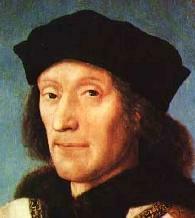 |
| Henry VII provided inspiration for at least two Targaryens |
Henry VII had been sent into exile during Edward IV's reign - as had Daenerys Targaryen (played by Emilia Clarke). Daenerys was the daughter of Aerys II and fled to Essos with her brother Viserys and the Mother of Dragons is currently planning a return to Westeros with her dragons to claim the Iron Throne.
 |
| The exiled 'Mother of Dragons' Daenerys Targaryen |
Henry Tudor was descended from the Welsh Tudor family and he flew the Welsh Dragon on his banners when he successfully won the crown by defeating Richard III at the Battle of Bosworth in 1485. This would then usher in the Tudor dynasty that ruled England for over 100 years.
HOUSES TULLY & TYRELL/NEVILLE
In order to successfully claim the throne you need support from lesser families. The Neville family descended from the Beauforts of John of Gaunt were originally sympathetic to the Lancastrian cause. Ralph Neville betrothed his nine-year-old daughter, Cecily Neviile to the Duke of York, similar to Catelyn Tully's betrothal to Ned Stark.
 |
| Bryden 'Blackfish' Tully resembled the Earl of Salisbury |
Salisbury's son, the Earl of Warwick, would also look to betroth his children in order to affirm his power. His eldest daughter, Isabel, was married to George, Duke of Clarence, as part of Warwick's original plan to overthrow Edward IV but this provided to be futile. Warwick would then use his other daughter, Anne, in a marriage with Lancastrian Prince Edward, in a second attempt to overthrow Edward IV.
Anne Neville would go from a Lancastrian Princess to a Yorkist Queen when Anne later married Richard, Duke of Gloucester, and became Queen Consort when Richard became king in 1483.
 |
| Anne Neville would be Princess and later Queen |
Margaery Tyrell (played by Natalie Dormer) would also rise to power and told Littlefinger that she wants to be "THE queen" and not just a queen after the death of her betrothed Renly.
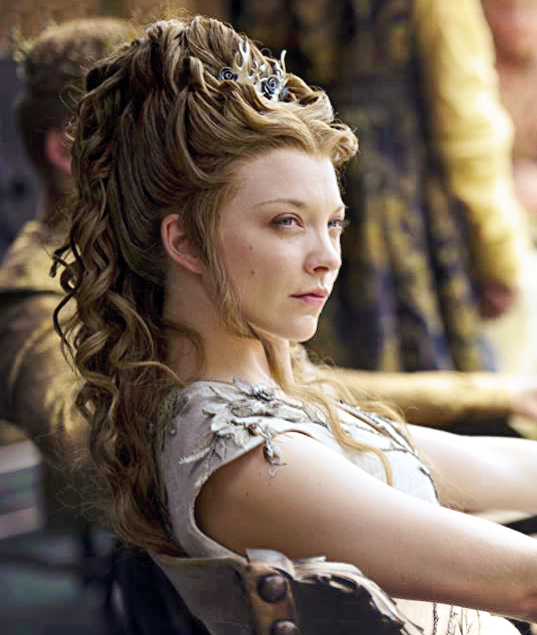 |
| Margaery Tyrell has aligned herself with two kings and one pretender |
The Tyrells soon joined Tywin Lannister in fighting back Stannis' attack on King's Landing at the Battle of Backwater Bay and were rewarded by having Margaery betrothed to King Joffrey. Not to be deterred by Joffrey's death (engineered by Margaery's grandmother) Margaery would set her sights on the next king, Tommen Baratheon.
SIGILS & MOTTOS
Heraldry rose in prominence during the Middle Ages where soldiers could identify friend or foe on the battlefield. This soon developed into coats of arms where family lineage and personal emblems were displayed. Unlike the family sigils of Westeros, medieval banners would contain different emblems amongst family members.
Whilst the Starks fought below Direwolf banners, the Yorkists flew under the Falcon and Fetterlock of the Duke of York, the Sunne in Splendour of Edward IV, the Black Bull of Duke of Clarence and the White Boar of Richard III. The White Rose of York was used early on during the so-called Wars of the Roses whilst the Red Rose of Lancaster was only used towards the end of the conflict with the banner of the Welsh Red Dragon being flown by Henry Tudor's men.
 |
| The York symbols White Rose and Falcon & Fetterlock |
Each family in Westeros has it's own motto such as Stark's "Winter Is Coming" or Lannister's "Hear Me Roar!" Mottos were usually reserved for English royalty and usually invoked fealty and loyalty with Edward IV's "Comfort and Joy", Richard III's "Loyalty Binds Me" and Henry VI's "God And My Right."






